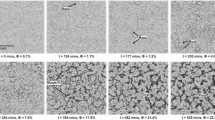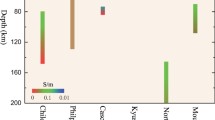Abstract
Pressure is a key control on the progress of metamorphic reactions. When fluids are present in rocks, the fluid pressure is commonly different to the load supported by the solid framework. Here, we show experimentally that, when the two pressures are varied independently, fluid pressure exerts the dominant control on reaction rate, even when the rock is compacting. We present 35 experiments on gypsum dehydration with independently controlled confining pressure, pore fluid pressure and temperature. Results show that a pore fluid pressure decrease at constant confining pressure has a strong effect on the average rate of the reaction. A decrease in confining pressure at constant pore fluid pressure has relatively little effect. Our results have implications for reaction kinetics: even though the product phase is supporting more and more load as reaction proceeds, that load does not appear to exert a chemical effect. On the large scale, our results imply that changes in fluid pressure will drive or stop the progress of metamorphic reactions. When estimating depth at which a metamorphic devolatilization reaction occurs, knowledge of the pore fluid pressure may be necessary rather than commonly used lithostatic pressure. This is relevant for basin diagenesis, mineralization in hydrothermal systems and chemical evolution after pore fluid pressure is perturbed by earthquakes.







Similar content being viewed by others
References
Ague JJ, Park J, Rye DM (1998) Regional metamorphic dehydration and seismic hazard. Geophys Res Lett 25(22):4221–4224
Bear J, Bachmat Y (1991) Introduction to modelling of transport phenomena in porous media. Kluwer, London
Bruton CJ, Helgeson HC (1983) Calculation of the chemical and thermodynamic consequences of differences between fluid and geostatic pressure in hydrothermal systems. Am J Sci 283A:540–588
Dahlen FA (1992) Metamorphism of nonhydrostatically stressed rocks. Am J Sci 292(3):184–198
de Meer S, Spiers CJ (1995) Creep of wet gypsum aggregates under hydrostatic loading conditions. Tectonophysics 245(3–4):171–183
Fusseis F, Schrank C, Liu J, Karrech A, Llana-Fúnez S, Xiao X, Regenauer-Lieb K (2011) Unravelling gypsum dehydration by combining 4-dimensional Synchrotron tomography and thermodynamic models. Solid Earth Discuss 3:857–900
Fyfe WS, Price NJ, Thompson AB (1978) Fluids in the earth’s crust: their significance in metamorphic, tectonic and chemical transport processes. Elsevier Scientific Pub. Co.: distributions for the U.S. and Canada Elsevier/North-Holland, Amsterdam, New York
Hanshaw BB, Bredehoeft JD (1968) On maintenance of anomalous fluid pressures: II. Source layer at depth. Geol Soc Am Bull 79(9):1107–1122
Heard HC, Rubey WW (1966) Tectonic implications of gypsum dehydration. Geol Soc Am Bull 77(7):741–760
Hildyard RC, Prior DJ, Mariani E, Faulkner DR (2009) Crystallographic preferred orientation (CPO) of gypsum measured by electron backscatter diffraction (EBSD). J Microsc Oxf 236(3):159–164. doi:10.1111/j.1365-2818.2009.03292.x
Hildyard RC, Llana-Fúnez S, Wheeler J, Faulkner DR, Prior DJ (2011) Electron backscatter diffraction (EBSD) analysis of bassanite transformation textures and crystal structure produced from experimentally deformed and dehydrated gypsum. J Petrol 52(5):839–856
Holland TJB, Powell R (1998) An internally consistent thermodynamic data set for phases of petrological interest. J Metamorph Geol 16(3):309–343
Kelley KK, Southard JC, Anderson CT (1941) Thermodynamic properties of gypsum and its dehydration products. Bureau of mines technical paper, US Department of Interior 625:1–73
Ko SC, Olgaard DL, Briegel U (1995) The transition from weakening to strengthening in dehydrating gypsum—evolution of excess pore pressures. Geophys Res Lett 22(9):1009–1012
Ko SC, Olgaard DL, Wong TF (1997) Generation and maintenance of pore pressure excess in a dehydrating system 1. Experimental and microstructural observations. J Geophys Res Solid Earth 102(B1):825–839
Lasaga AC (1997) Kinetic theory in the earth sciences. Princeton University Press, Princeton
Llana-Fúnez S, Brodie KH, Rutter EH, Arkwright JC (2007) Experimental dehydration kinetics of serpentinite using pore volumometry. J Metamorph Geol 25:423–438
McConnell JDC, Astill DM, Hall PL (1987) The pressure-dependence of the dehydration of gypsum to bassanite. Mineral Mag 51(361):453–457
Miller SA, van der Zee W, Olgaard DL, Connolly JAD (2003) A fluid-pressure feedback model of dehydration reactions: experiments, modelling, and application to subduction zones. Tectonophysics 370(1–4):241–251
Milsch HH, Scholz CH (2005) Dehydration-induced weakening and fault slip in gypsum: Implications for the faulting process at intermediate depth in subduction zones. J Geophys Res Solid Earth 110(B4):1–16
Milsch H, Priegnitz M, Blöcher G (2011) Permeability of gypsum samples dehydrated in air. Geophys Res Lett 38:6
Mirwald PW (2008) Experimental study of the dehydration reactions gypsum-bassanite and bassanite-anhydrite at high pressure: Indication of anomalous behavior of H2O at high pressure in the temperature range of 50–300 degrees C. J Chem Phys 128(7). doi:10.1063/1.2826321
Mitchell TM, Faulkner DR (2008) Experimental measurements of permeability evolution during triaxial compression of initially intact crystalline rocks and implications for fluid flow in fault zones. J Geophys Res Solid Earth 113(B11). doi:10.1029/2008jb005588
Olgaard DL, Ko SC, Wong TF (1995) Deformation and pore pressure in dehydrating gypsum under transiently drained conditions. Tectonophysics 245(3/4):237–248
Partridge EP, White AH (1929) The solubility of calcium sulfate from 0 to 200°C. J Am Chem Soc 51:360–370
Paterson MS (1973) Nonhydrostatic thermodynamics and its geologic applications. Rev Geophys Space Phys 11(2):355–389
Posjnak E (1938) The system CaSO4-H2O. Am J Sci 35A:247–272
Rubie DC, Thompson AB (1985) Kinetics of metamorphic reactions at elevated temperatures and pressures: an appraisal of available experimental data. In: Thompson AB, Rubie DC (eds) Metamorphic reaction kinetics, textures, and deformation, vol. Springer, Berlin, pp 27–79
Rutter EH, Llana-Fúnez S, Brodie KH (2009) Dehydration and deformation of intact cylinders of serpentinite. J Struct Geol 31(1):29–43. doi:10.1016/J.Jsg.2008.09.008
Sibson RH (2004) Controls on maximum fluid overpressure defining conditions for mesozonal mineralisation. J Struct Geol 26(6–7):1127–1136. doi:10.1016/j.jsg.2003.11.003
Sibson RH, Robert F, Poulsen KH (1988) High-angle reverse faults, fluid-pressure cycling, and mesothermal gold-quartz deposits. Geology 16(6):551–555
Stretton I (1996) An experimental investigation of the deformation properties of gypsum. PhD, University of Manchester
Stretton IC, Schofield PF, Hull S, Knight KS (1997) The static compressibility of gypsum. Geophys Res Lett 24(10):1267–1270
Tenthorey E, Cox SF (2003) Reaction-enhanced permeability during serpentinite dehydration. Geology 31(10):921–924
Wang WH, Wong TF (2003) Effects of reaction kinetics and fluid drainage on the development of pore pressure excess in a dehydrating system. Tectonophysics 370(1–4):227–239
Wheeler J (1987) The significance of grain-scale stresses in the kinetics of metamorphism. Contrib Mineral Petrol 97(3):397–404
Wong TF, Ko SC, Olgaard DL (1997) Generation and maintenance of pore pressure excess in a dehydrating system. 2. Theoretical analysis. J Geophys Res Solid Earth 102(B1):841–852
Yamamoto H, Kennedy GC (1969) Stability relations in system CASO4–H2O at high temperatures and pressures. Am J Sci 267:550–557
Zen EA (1965) Solubility Measurements In System Caso4–NaCl–H2O At 35°, 50°, And 70°C and one atmosphere Pressure. J Petrol 6(1):124–164
Acknowledgments
This research was funded by NERC grant NE/C002938/1. SLF acknowledges funding from Subprograma Ramón y Cajal (Ministerio de Ciencia e Innovación) RYC-2008-02067 during the writing of this paper. Earlier version of the manuscript benefited from constructive reviews by Stephen Cox and Bruce Yardley. For the new version, authors need to thank the feedback given by Ten-fong Wong and the editor, Jon Blundy.
Author information
Authors and Affiliations
Corresponding author
Additional information
Communicated by J. Blundy.
Electronic supplementary material
Below is the link to the electronic supplementary material.
Rights and permissions
About this article
Cite this article
Llana-Fúnez, S., Wheeler, J. & Faulkner, D.R. Metamorphic reaction rate controlled by fluid pressure not confining pressure: implications of dehydration experiments with gypsum. Contrib Mineral Petrol 164, 69–79 (2012). https://doi.org/10.1007/s00410-012-0726-8
Received:
Accepted:
Published:
Issue Date:
DOI: https://doi.org/10.1007/s00410-012-0726-8




